Abstract
Background: The potential oncologic benefit of adding neck dissection to thyroidectomy procedures is balanced with a presumed increased
morbidity from more extensive surgery. Although there has been some literature documenting the risks of adverse events (AE) from neck
dissection in single institutions, there has not been a large volume analysis to investigate this issue.
Methods: The American College of Surgeons National Surgical Quality Improvement Program (ACS-NSQIP) 2005–2012 registry was
queried to identify all patients undergoing thyroidectomy, with or without associated neck dissection. Patients were propensity-score matched
1:1 for preoperative factors. Outcomes of interest included surgical wound and medical complications, reoperation, and mortality. Univariate and
multivariate analyses were utilized to identify predictors of these events. Odds ratios were calculated for adverse events between cohorts.
Results: A total of 44,887 patients were identified for analysis. Of these, 38,449 (85.4%) underwent an isolated thyroidectomy (IT) procedure
without neck dissection, and 6,438 (14.6%) underwent a thyroidectomy with neck dissection (TND). After matching, there were 4,814 patients
found to have similar pre-operative co morbidities, demographics and operative factors. There was a higher rate of overall complications in the
IT group (4.25%) than the TND group (3.00%, p<0.001). There was no statistically significant difference in surgical complications. There was,
however, a statistically significant increase in medical complications in the IT group (3.83%) over the TND group (2.68%, p=0.005). There was
no difference in post-operative mortality between both groups. There was a higher rate of return to the operating room for the IT group (2.54%)
compared to the TND group (1.54%, p=0.004).
Conclusions: The morbidity and mortality of thyroid surgery is relatively low overall. In this analysis there was no measurable increase in
the complications conferred by the addition of a neck dissection. These data are important for patient informed consent, risk stratification, and
surgical planning.
Keywords
Thyroidectomy; NSQIP; Neck dissection; Outcomes; Mortality; Complications
Introduction
The rate of thyroid cancer is increasing, but it is unknown whether this
represents a true increase in incidence, or an increased detection rate of
cancer in smaller nodules. The rate for new diagnoses of thyroid cancer has
increased an average of 6.4% per year over the last 10 years, and mortality
of thyroid cancer has increased 0.9% per year over the same period [1].
It has long been suggested that the presence of cervical metastasis of
differentiated thyroid cancer does not affect survival. This was reflected
in the various prognostic scoring systems of AMES, AGES, and MACIS
[2,4]. One study challenged this dogma, noting there was increased
survival with prophylactic removal of lymph nodes [5]. However there is
ongoing debate regarding the need for prophylactic neck dissection.
The potential oncologic benefit of adding neck dissection to
thyroidectomy procedures is balanced, however, with a presumed
increased morbidity from more extensive surgery. Although there has
been some literature documenting the risks of hypoparathyroidism
[6] and recurrent laryngeal nerve injury from neck dissection in single
institutions, there has not been a large volume analysis to investigate
potential increased risks of overall medical and surgical complications
with the addition of neck dissection to a thyroidectomy procedure [7].
The American College of Surgeons (ACS) National Surgical Quality
Improvement Program (NSQIP) is a multi-institutional collaborative
effort that collects data from more than 500 hospitals. The data include
135 variables including preoperative status, intra operative variables, and
postoperative outcomes, including 30-day postoperative morbidity and
mortality. The NSQIP database is an excellent resource for populationbased
analyses of critical health care issues, including registry-based trials,
risk adjustment, surgical outcomes and cost [8].
The purpose of this study was to use the ACS-NSQIP database to evaluate
a high volume of patients to assess whether adding a neck dissection to
a thyroidectomy conferred more risk of complications. Although most
reports on thyroidectomy outcomes focus on technical complications
such as recurrent laryngeal nerve injury and hypo parathyroidism, we
sought to understand nontechnical complications that occurred with the
addition of neck dissection to thyroid surgery.
Methods
Data acquisition and patient population
Data collection methods for the American College of Surgeons
National Surgical Quality Improvement Program (NSQIP) registry have
been previously described [9,10].All study aspects were approved by the
respective Institutional Review Boards.
The American College of Surgeons National Surgical Quality
Improvement Program (ACS-NSQIP) 2005 – 2012 registry was queried.
The ACS-NSQIP is a prospectively validated multi-institutional database
which began in 2004 and provides comprehensive preoperative, per
operative, and 30-day postoperative data for 2.3 million de-identified
patients from over 460 participating institutions across the United States.
Patients with only primary current procedural terminology (CPT) codes
60220, 60225, and 60240 were stratified to the isolated thyroidectomy (IT)
group. The thyroidectomy with neck dissection (TND) group consisted
of patients with only primary CPT code 60252 or 60254. The CPT codes
used are shown in (Table 1).
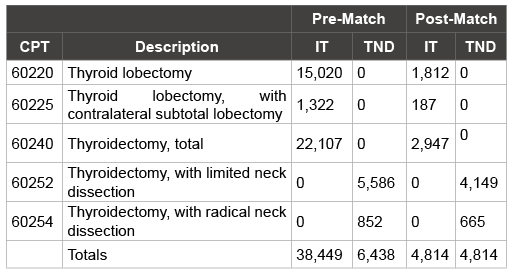
Table 1: Pre- and post-match patient cohort totals, versus American
Medical Association’s Current Procedural Terminology codes.
CPT= Current Procedural Terminology Code; IT=Isolated Thyroidectomy;
TND=Thyroidectomy with Neck Dissection
Peri-operative variables
Preoperative variables defined in NSQIP included demographic
variables age, sex, race, and BMI, medical co morbidities including
diabetes, dyspnea, COPD, previous cardiac surgery, pervious stroke,
hypertension, disseminated cancer, wound infection, steroid use, bleeding
disorders, chemotherapy, radiotherapy, sepsis, wound class, and ASA
class, and intraoperative characteristics including inpatient status and
total RVU.
The primary outcomes of interest were 30-day complication rates,
categorized as surgical wound complications, medical complications, and
overall complications. Surgical wound complications included superficial,
deep, or organ-space surgical site infection (SSI), wound dehiscence.
Medical complications examined included pneumonia, unplanned
reintubation, pulmonary embolism, ventilator dependence >48 hours,
urinary tract infection, stroke, peripheral nerve injury, cardiac arrest,
myocardial infarction, blood transfusions, deep vein thrombosis (DVT),
sepsis, and septic shock. Return to the operating room and death were
also included in this analysis as separate entities.
Statistical analysis
Patients were propensity score matched to balance out differences between the patient populations.
For each patient, the variables in (Table 2) were used to model their probability for undergoing an outpatient procedure. Using these values, IT patients were paired with the nearest TND procedure without replacement in a
1:1 ratio. When a close match was not available, the case was eliminated. Specific variables included for matching included: age, BMI, current smoking status, current alcohol abuse, diabetes mellitus, dyspnea, COPD, previous cardiac
surgery, previous TIA or stroke, hypertension, disseminated cancer, current steroid or immunosuppressant use, history of bleeding disorder, history of chemotherapy, history of radiotherapy, current sepsis, wound class, and hospital setting.
Propensity score matching was carried out in SPSS (IBM Corp, Armonk, NY), and has been previously described
in detail [11-13].
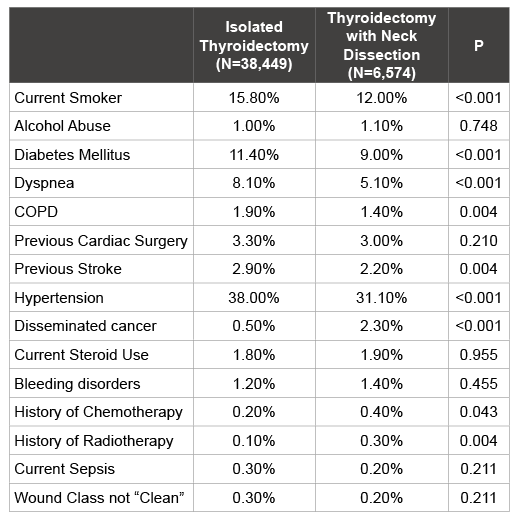
Table 2: Preoperative and Operative Characteristics of Pre-Match Cohorts
Comparison of the descriptive statistics and outcomes for the matched
cohorts was performed using chi-square tests for categorical variables and
Student’s t test for continuous variables, with significance defined as p
<0.05. Statistical evaluation of outcomes was not evaluated for unmatched
cohorts. Multiple logistic regression models with adjusted odds ratios for
complications, return to OR, and death were constructed. Perioperative
variables with n ≥ 10 and p <0.2 as identified in a bivariate screen were
included in the regression models. Again, p <0.05 was considered
significant. C-statistics were calculated to assess model discriminatory
capability. All analyses were performed using SPSS version 22 (IBM Corp.,
Armonk, NY).
Results
A total of 44,887 patients were identified for analysis, of which 38,449
(85.4%) underwent an isolated thyroidectomy (IT) procedure without
neck dissection, and 6,438 (14.6%) underwent a thyroidectomy with neck
dissection (TND).
The mean age was 51.48 years in the IT group compared to 48.72 in the
TND group (p<0.001). Males made up 18.2% of the IT group compared
to 26.3% in the TND group (p<0.001). BMI was slightly higher in the IT
group 29.77 (SEM 7.5) compared to the TND group (SEM 7.02, p<0.001).
American Society of Anesthesiologists (ASA) classification 1 or 2 was
assigned to 74.7% of those undergoing isolated thyroidectomy compared
to 70.9% in those undergoing thyroidectomy with neck dissection
(p<0.001).
Preoperative characteristics are described in (Table 2). Within the
isolated thyroidectomy group there was a significantly higher incidence
of patient smoking (15.8% vs 12%, p<0.001), diabetes mellitus, dyspnea
(11.4% vs 9%, p<0.001), chronic obstructive pulmonary disease (1.9% vs
1.4%, p=0.004), stroke (2.9% vs 2.2%, p=0.004), and hypertension (38%
vs 31.1%, p<0.001). The thyroidectomy with neck dissection group had
significantly higher rates of disseminated cancer (2.3% vs 0.5%, p<0.001),
as well as history of radiotherapy (0.3% vs 0.1%, p=0.004). Wound
classification was more likely to be clean in the isolated thyroidectomy
group (98% vs 96.9%, p<0.001). Operative times were longer (180.5 vs
111.3 minutes, p<0.001) and total relative value units (RVUs) were higher
(28.96 vs 15.72, p<0.001) in the thyroidectomy with neck dissection group.
Matching of preoperative characteristics outlined in the methods
section was performed to have homogenous groups for analysis. After
matching, there were 4,814 patients found to have similar pre-operative
co morbidities and demographics, as seen in (Table 3).
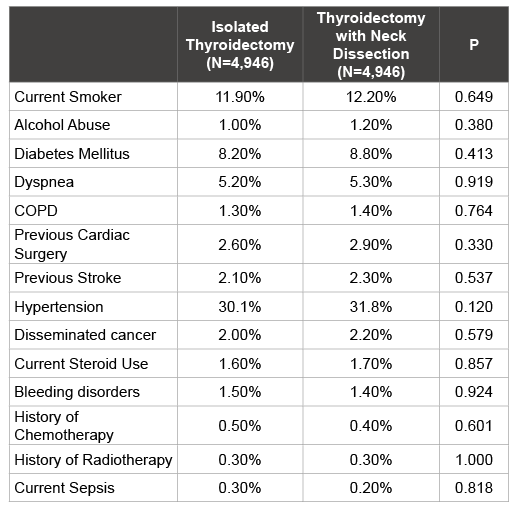
Table 3: Preoperative Characteristics of Post-match Cohorts
Complications for the IT and TND groups, in the matched cohort, are
reported in (Table 4). There was a higher rate of overall complications in
the IT group (4.25%) than the TND group (3.00%, p<0.001). There was no
statistically significant difference in surgical wound complications among
the IT cohort (0.65%) and the TND cohort (0.47%, p=0.284). However, a
statistically significant increase in medical complications in the IT group
(3.83%) over the TND group (2.68%, p=.005) was noted. With regard to
the IT cohort, there were trends for higher rates of unplanned reintubation,
pulmonary embolism, prolonged post-operative ventilation, urinary
tract infection, myocardial infarction, blood transfusion, deep venous
thrombosis, and sepsis, but none of these were statistically significant. The
only individual complication that reached statistical significance was postoperative
stroke (0.16% for IT vs 0.00% for TND, p=0.014). There was no
difference in post-operative mortality between each cohort. There was a
higher rate of return to the operating room for the IT group compared to
the TND group (2.54% vs1.54%, p=0.004).
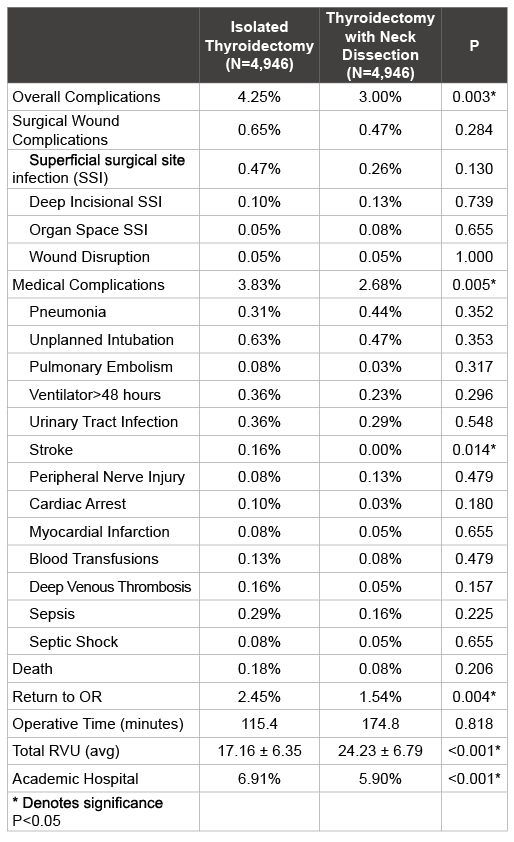
Table 4: Unadjusted Outcomes of Matched Cohorts
Odds ratio analysis was performed between the IT and TND groups
for the matched cohort, as seen in (Table 5). With reference to the isolated
thyroidectomy group, the thyroidectomy with neck dissection group had
a significant adjusted odds ratio <1 for overall complications, medical
complications, and return to the operating room.
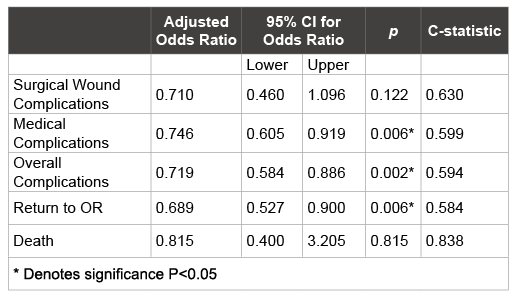
Table 5: 30-day Complications Odds Ratio of TND vs IT
Discussion
Differentiated thyroid cancer (comprised of papillary thyroid cancer
and follicular thyroid cancer) makes up approximately 90% of all thyroid
cancers overall [14]. Nodal metastases are known to significantly correlate
with persistence and recurrence of disease, and micrometastases are
found in up to 90% of prophylactically dissected neck compartments
[15,16]. Neck dissection was first described in 1986 for medullary
thyroid carcinoma as a method to decrease tumor burden and favorably
impact overall survival [17]. Thereafter neck dissection was introduced
for papillary thyroid carcinoma [18]. Although it was traditionally
held that the presence of cervical metastases did not affect survival
in thyroid cancer, this dogma has recently been challenged by a large
population-based study demonstrating decreased survival in patients
with cervical metastases [5,19,20]. The risks and benefits must also be
weighed regarding the potential need for a reoperation neck dissection
following a thyroidectomy and the obstacles this may practically impose.
Notwithstanding the controversy surrounding elective neck dissection in
a clinically negative neck, there is general consensus about the utility of
therapeutic neck dissection for the treatment of macroscopic lymph node
metastases [21,22]. However, little is known about the attendant surgical
morbidity associated with neck dissection after thyroidectomy.
The NSQIP database is a unique and robust database with large volumes
that can support critical analyses of risk factors with small confidence
intervals. NSQIP collects data from both major academic tertiary-care
medical centers as well as community hospitals, thereby capturing a
broad snapshot of procedures and patients with their preoperative risks
and postoperative outcomes. Because the data is prospectively collected
and validated by a highly-trained and dedicated surgical clinical nurse
reviewer (SCNR), the NSQIP has a large advantage over other registry
and Medicare-based analyses that are primarily administrative discharge
datasets without emphasis on accuracy.
A major weakness of the NSQIP database is that it was designed to
capture data for all surgeries with general complications as the assessment
goal; therefore, some procedure-specific information is not collected.
For example, data on thyroidectomy does not include information on
injury to the recurrent laryngeal nerve nor on the rate of hypocalcemia.
Information on post-operative hematoma is not tracked, but some
authors have used the information on “bleeding requiring transfusion”
or “reoperation” as a surrogate for the development of neck hematoma
[23]. Hypocalcaemia is not specifically tracked in 30-day outcomes, but
can be identified from diagnosis codes from patients who are readmitted
[24]. Neither recurrent laryngeal nerve, nor spinal accessory nerve
injury are specifically tracked, although NSQIP does have an entry for
“peripheral nerve injury”. In our analysis, peripheral nerve injury was
elevated (although non-significantly) in the TND cohort. Unfortunately,
NSQIP is unable to determine if this is due to direct injury to cranial
nerves 10, 11, or 12 exposed in a neck dissection, or simply a reflection
of transient neuropathies from poor positioning on the operating room
table, which may occur more frequently with longer operating times.
Another weakness is that NSQIP does not allow comparisons between
high volume and low volume surgeons, nor between high volume and
low volume institutions; therefore, conclusions cannot be made regarding
surgical outcomes among these groups. Furthermore, specific diagnosis
codes are not well accounted for in the setting of thyroidectomy within the
dataset, hindering the specific comparison of those patients undergoing
thyroidectomy for benign versus malignant disease processes. In addition,
NSQIP does not differentiate between central and lateral neck dissections
in the CPT codes 60252 and 60254 utilized in this study, also hindering
the specific comparison of patients undergoing these two procedures.
However, we did not aim to compare these disease processes and specific
procedures, but rather to compare complications by merely adding a neck
dissection to a thyroidectomy.
A 2014 NSQIP study assessed how various preoperative co morbidities
and intraoperative variables were tied to thyroidectomy outcomes [25].
In an analysis of 38,577 cases they found that risk factors independently
associated with morbidity after thyroidectomy included hypertension,
diabetes, advanced age greater than 70 years, COPD, and dialysis.
Interestingly they found that the surgical approach was related to the rate
of return to the operating room. As compared with a partial thyroidectomy,
patients undergoing a total thyroidectomy were 73% less likely to return to
the operating room and those undergoing sub sternal thyroidectomy were
37% less likely to return to the operating room.
In our study the 30 day mortality was 0.18% for isolated thyroidectomy
and 0.08% for thyroidectomy with neck dissection. These mortality
rates compare favorably with mortality rates of other procedures
such as pancreatectomy (8.3%), coronary artery bypass graft (3.5%),
craniotomy (10.7%), and repair of aortic aneurysm (3.9%) [26]. The
overall complication rates found in our study were also low; 4.25% for
isolated thyroidectomy and 3.0% for thyroidectomy with neck dissection.
This underscores the relative safety profile of thyroidectomy procedures.
Thyroidectomy surgeons and hospitals should use these data as a
benchmark to compare their own rate of complications and improve their
own quality control.
Rates of reoperation were significantly decreased in the TND group,
compared to IT (OR 0.689, p=0.006). It seems reasonable that the increase
in reoperation among the IT cohort may be accounted for by the need
for completion thyroidectomy after a diagnostic lobectomy within the IT
cohort. In fact, Qin et al. found that thyroid lobectomy had a higher rate
of return to the operating room than total thyroidectomy [27]. Naturally,
it would be expected that there would be an increased rate of hematoma
with increased extent of surgery in the TND group compared to the IT
group; but it appears that using rate of reoperation as a surrogate for
development of hematoma is a dangerous assumption, and we would
recommend against it for future NSQIP analyses.
It could easily be reasoned that the increased surgery of TND would
confer more risk of complication than IT. Interestingly however, surgical
wound complications were no different between cohorts on multivariable
analysis, and surprisingly, postoperative medical complications were
higher in the isolated thyroidectomy group. What is the driver behind the
significantly increased medical (and thus, total) complications in the IT
cohort?
On close examination, a number of hypotheses to explain these
differences between IT and TND cohorts emerge. Case volume has been
shown to correlate with outcomes after thyroidectomy, but is not tracked
in NSQIP. Perhaps hospital setting could be used as a surrogate for case
volume, as academic centers arguably are referred more advanced cases of
thyroid carcinoma requiring neck dissection. Pre-match, the TND group
had a higher percentage of academic medical centers (28.5% vs 25.3%, p<
0.05). Post-match, this difference was reversed, thus eliminating hospital
setting as a possible reason for the differences seen in outcomes (5.9% vs
6.9%, p< 0.05). It is possible that case volume does indeed correlate with
outcomes in these cohorts, but that “academic versus community” setting
is not an accurate surrogate for this variable. It could also be reasoned that
academic teaching hospitals may have different post-operative admitting
protocols after thyroidectomy than their community hospital cohorts;
and if the rates of post-operative admission differed in each group, then
certainly this could affect the number of complications recorded by the
NSQIP’s surgical clinical nurse reviewer.
In the analysis of matched cohorts (Table 4), overall complications were
increased in the IT cohort compared to the TND cohort. This difference
was not due to the surgical complications (no significant difference), but
rather due to the increased post-operative medical complications in the IT
cohort. Examination of the medical complications shows that, other than
stroke, there was no single adverse event that was significantly higher in
the IT group, but rather only in aggregate were the medical complications
statistically higher in the IT group. This difference was identified despite
the increased operative time and work RVU in the TND cohort (both
p<0.001). Given that there is no conceivable direct mechanism by which
IT could increase the risk of stroke or other medical complication, we
are limited to conjecture to explain this constellation of findings. It is
conceivable that patients undergoing TND receive a more extensive
preoperative workup, and more invasive postoperative monitoring, and
that these factors help to minimize rates of postoperative medical adverse
events.
In summary, this NSQIP analysis illustrates little to no objective
morbidity conferred to patients by the addition of neck dissection to
their thyroidectomy procedure in the matched cohort. No difference
occurred regarding surgical wound complications or mortality. Medical
complications, overall complications, and return to OR were significantly
elevated in the IT group. However, the difference in medical complications
was minimal (3.83% vs 2.68%), and should not be considered clinically
significant.
Conclusions
The general morbidity and mortality of thyroid surgery is relatively low.
In this analysis there was no measurable increase in general complications
conferred by the addition of a neck dissection. This conclusion is
guarded given the limitations of this study. Preoperative co morbidities
should be considered when weighing the risks of thyroid surgery and its
accompanying complications.
Financial Support
This particular research received no internal or external grant funding.
Conflicts of Interest
The authors report no relevant financial disclosures related to this
current work.
Ethical Approval
De-identified patient information is freely available to all institutional
members who comply with the American College of Surgeons National
Surgical Quality Improvement Program (NSQIP) Data Use Agreement.
The Data Use Agreement implements the protections afforded by the
Health Insurance Portability and Accountability Act of 1996.
Disclaimer
The NSQIP and the hospitals participating in the NSQIP are the source
of the data used herein; they have not been verified and are not responsible
for the statistical validity of the data analysis, or the conclusions derived
by the authors of this study.






